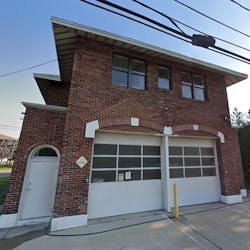Shortly after World War I, Norfolk was expanding. The city in early 1923 had just annexed 30 square miles of land from surrounding Norfolk County and with the 30,000 additional residents it brought came renewed public safety concerns.
The land taken during the “great annexation" included military installations as well as rural areas transitioning to denser city suburbs, and city officials knew the increasing development required better police and fire protection.
So it was that Fire Station No. 12 came to be built at 1650 W. Little Creek Road, along with four others in the area. It’s one of two still standing and was recently added to the Virginia Landmarks Register, a symbolic designation marking its importance in city history. The station is now one of 65 such sites in Norfolk, along with the Wells and Attucks theaters, Elmwood Cemetery and USS Wisconsin.
“This firehouse is a great example of a building that’s retained its essential historic fabric and setting," said Randy Jones, spokesman for the state’s Department of Historic Resources. “And it’s been restored to look pretty much like it did in 1923.”
Razzo Properties LLC, which bought the building from the city last year and spent nearly half a million dollars restoring its facade, plans to make it into a restaurant.
The No. 12 two-story, brick firehouse was designed in the “American Foursquare” style with Craftsman features, according to its National Register of Historic Places registration form. It was common in that era for stations to be designed to blend in with surrounding houses in the neighborhood, Jones said.
Surrounding communities included Titustown, “originally developed as a model residential suburb for middle- and working-class African Americans during the Jim Crow era,” according to the registration form. North was the U.S. Army Supply Base at Sewell’s Point that would become the Navy base.
Norfolk had established its first paid fire department in 1871, after more than a century of volunteer fire companies. By the Little Creek station’s commissioning in early 1924, the city had the latest firefighting technology, including an Ahrens-Fox Fire Engine, according to the application, as horse-drawn engines were retired.
Home to one of the first Red Cross First Aid Road Stations in 1936, the station’s crew became known for their first aid specialty. One time, a young girl brought in her injured dog, Whitey. The firemen “set his leg with splints and friction tape” and the dog became a station mascot, according to a 1941 Virginian-Pilot article.
The station can also be seen as a symbol of the many changes that came to Norfolk and the country over the 20th century, applicants wrote.
During World War II, as men were increasingly called upon to serve in the military, the fire ranks were dwindling, according to the registration form. Volunteers trained in firefighting as well as bombs, gases and explosives.
In the 1960s, Norfolk’s fire department started to integrate. Despite the Civil Rights Act of 1964, a black man wouldn’t be hired in the department until 1967, according to the application. Black firefighters were consistently discriminated against, and in the wake of several lawsuits, the city in 1978 filed a consent decree requiring 30% of all entry-level positions to be filled by black applicants and women.
The No. 12 fire station was used until 2018, when the city constructed a new one across the street. Its facade had been altered in 1957 and again in 1998 to accommodate larger fire engines, but its historic arches were restored by Razzo Properties this year.
It’s “a rare historic resource associated with the City of Norfolk’s early twentieth century growth patterns and the evolution of firefighting technology and safety standards,” applicants wrote.
Jones said the historic resources department has a review board that goes through nominated properties. Any that are added to the list must meet one of four criteria — in the station’s case, it was its association with a pattern of historical events. The landmark designation does not save a property from being sold or altered; its purpose is symbolic. The naming also allows property owners to pursue associated tax credits.
The station will now go on to be additionally considered for the National Register of Historic Places. Jones said a majority of Virginia landmarks make that list as well.
———
©2019 The Virginian-Pilot (Norfolk, Va.)
Visit The Virginian-Pilot (Norfolk, Va.) at pilotonline.com
Distributed by Tribune Content Agency, LLC.






